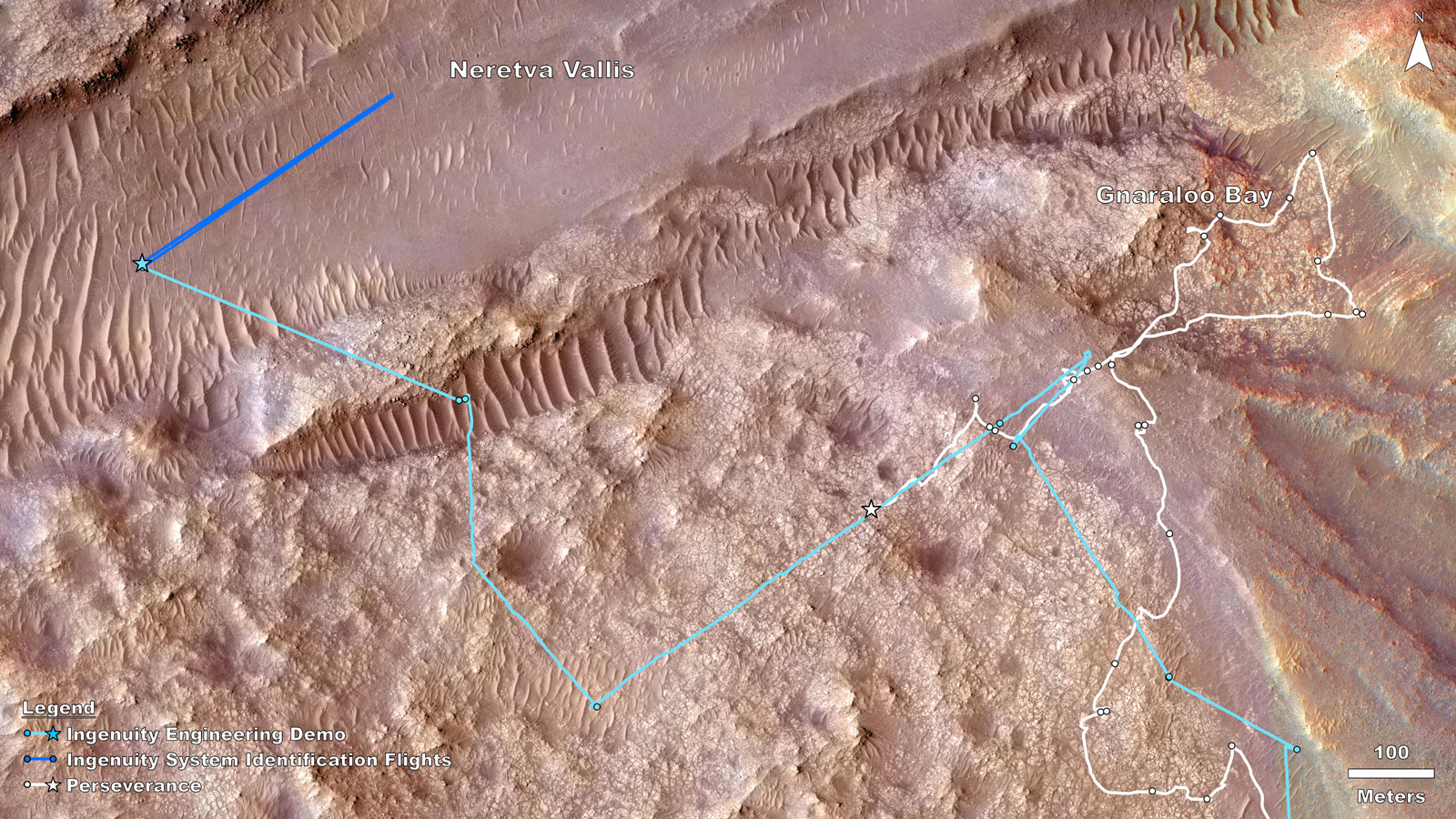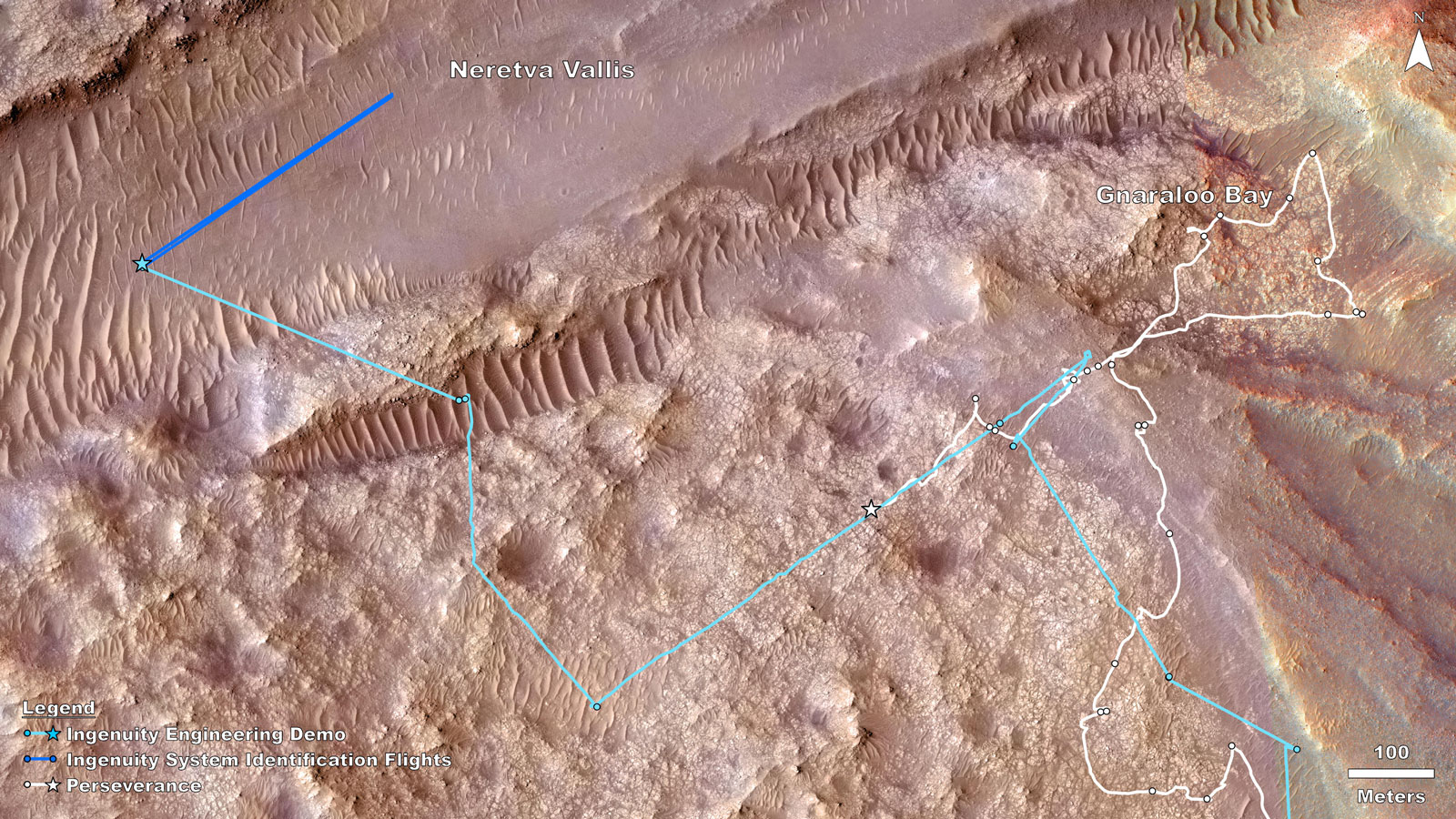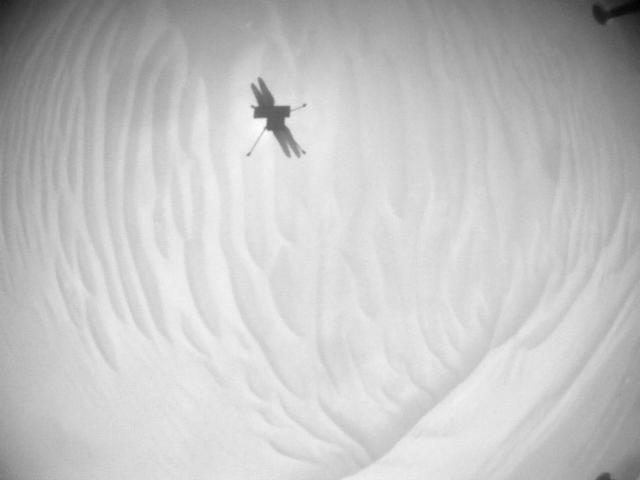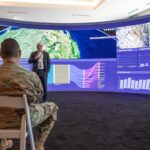Nowhere on Earth can we fully replicate the conditions on Mars. Special facilities can re-create certain elements with enough fidelity to test specific scenarios, but each is limited, leading to a plethora of platforms and scenarios required to span the conditions of Mars. In our prior post, “The Right Stuff,” the focus was using Ingenuity on Mars to test our macro capabilities: flying higher and faster, landing at various speeds, and generally expanding the flight envelope to retire the associated risk for future Martian rotorcraft. The holy grail, however, is understanding the microscale – not just proving Ingenuity can fly faster but knowing how it flies faster.
To answer the question, the NASA JPL Ingenuity team worked with our aerodynamics partners at NASA Ames to design, validate, and execute a Sys-ID test campaign. “Sys-ID” refers to a process called system identification, a data-driven method for understanding the complex behavior of a system by studying how specific inputs impact the motion of the vehicle.
In this case, a frequency sweep (sine wave with varying frequency) was injected into the control input to cause microscopic “nodding” of the vehicle in forward flight. The aerospace industry has long relied on these methods to characterize complex vehicle dynamics and validate simulation models. The same methods were used during ground testing of Ingenuity on Earth, but as previously noted, there was no comprehensive test environment on Earth to conduct full system testing like traditional Earth rotorcraft endure.
During the early phases of the mission, the required dynamic maneuvers were viewed as too risky to perform in-flight on Mars. As Ingenuity entered its third year of operations and neared the end of its ability to expand the flight envelope, the risks of Sys-ID became smaller and easier to justify. In late 2023, a three-month effort was spent to develop, test, and uplink a new software version that connected portions of Ingenuity’s software that were used for Earth-based Sys-ID testing with the code that controls the vehicle when flying horizontally.
Animation depicts control input that results in microscopic “nodding” of the vehicle in forward flight.
The opportunity to conduct a Sys-ID flight was found in December 2023. Conditions were ideal within the lower section of Neretva Vallis (believed to be an old river valley) due to the terrain being nearly as flat as on the crater floor. Additionally, the mission schedule allowed for a break from the regular flights needed to stay ahead of the rover as it was conducting a scientific loop through Gnaraloo Bay. Two dedicated flights (Flights 68 and 69) were executed that successfully demonstrated the Sys-ID method in-flight and, for the first time on another planet, characterized the vehicle’s flight dynamics.
These flights prioritized collecting data in high-speed forward flight conditions – both within and beyond Earth-based testing to correlate and extend our knowledge. The importance of this is highlighted by Allen Ruan, Ames aeromechanics flight dynamicist, “Getting the data from these two flights, especially at the high forward flight speeds, closes the loop on prior years of simulation and ground testing and informs us on improvements for dynamics modeling and estimation of future Martian rotorcraft.”
The reason that these flights are so significant is because they provide key fundamental validation of rotorcraft models and methods which would otherwise require conditions that are impossible to replicate here on Earth. As explained by Tove Aagren, lead simulator at Ames and designer of the Sys-ID campaign, “An inherent challenge of working with Mars rotorcraft is that of model validation. Extraterrestrial flight necessitates high confidence in our prediction models, yet replicating the true flight condition to gain this confidence across an entire flight envelope in Earth-based testing is highly non-trivial. To this day, aspects of forward flight dynamics of Ingenuity remain associated with uncertainty. This is what makes the opportunity to characterize key vehicle dynamics in the true operating condition, i.e. on Mars, incredibly exciting. Not only for the novelty of the approach, but for the fundamental insights that we really cannot gain in any other way than through designated system identification flights.”
In order to execute this type of maneuver, Ingenuity had to fly a record distance at the previously tested max groundspeed of 10 m/s (22.3 mph). An out-and-back flight with Sys-ID segments in each leg guaranteed that for an expected east-west wind direction at least one leg is into the wind enabling testing at an airspeed greater than 10 m/s. Getting two flights’ worth of data at these high speeds provides a treasure trove that allows the team to increase confidence in the behavior of future rotorcraft at Mars.
Additionally, now that these Sys-ID methods have been demonstrated successfully, a process has been established that can be replicated for characterizing future flight vehicles earlier in their mission. This would better define the vehicle’s performance, allowing the operations team to plan with fewer unknowns and could enable future rotorcraft to be tested on Earth to meet only the minimum capability needed to complete the mission, and then validated to higher levels of performance after landing.
With in-flight system identification complete, Ingenuity followed in the footsteps of countless legends, test pilots who first pushed the limits of aerial flight, then space flight, and now Martian flight.
Martin Cacan, Chief Pilot for Ingenuity Mars Helicopter at NASA’s Jet Propulsion Laboratory, and Shannah Withrow-Maser, Rotorcraft Aeromechanics Lead at NASA’s Ames Research Center
























